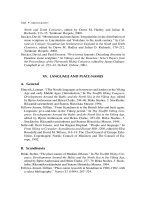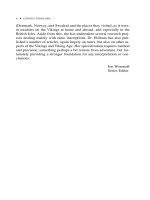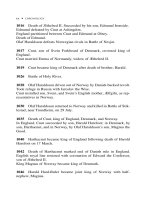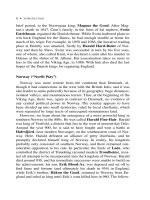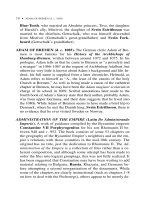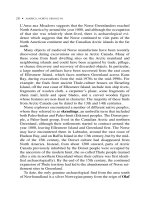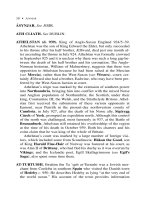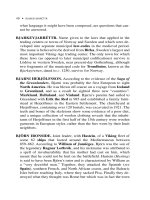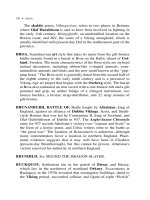The A to Z of the Vikings 15 pdf
Bạn đang xem bản rút gọn của tài liệu. Xem và tải ngay bản đầy đủ của tài liệu tại đây (56.92 KB, 10 trang )
known for certain about Halfdan and his reign, although he appears
to have inherited control of the southern province of Agder at the age
of 18 and to have acquired Vestfold, Romerike, Sogn, Hadeland by
force. Snorri Sturluson’s saga about Halfdan is short, includes many
dreams and premonitions, and lacks any skaldic verse to substantiate
the prose narrative. Halfdan is said to have had two wives called
Ragnhild and two sons called Harald; the first of these sons died, but
the second, Harald Fine-Hair, became king of Norway after his fa-
ther’s death. Halfdan is said to have died at the age of 40 and to have
been buried in the province of Ringerike.
HAMBURG-BREMEN. See ADAM OF BREMEN; ANSGAR, ST.
HARALD BLUE-TOOTH (ON Haraldr blátand) (d. c. 987). King of
Denmark and son of Gorm the Old and Thyre. Harald ruled from the
dynastic seat his father had established in Jelling, Jutland, Denmark. On
a rune-stone that Harald raised in Jelling, he claimed to have united
Denmark under one king, to have converted the Danes to Christianity,
and to have also won control of Norway (which he then ruled through
his Norwegian ally, Hákon Jarl of Lade). Widukind’s Saxon Chroni-
cle preserves an account of Harald’s conversion c. 965, attributing it to
the German missionary, Poppo, who held a piece of red-hot iron in his
hands to prove to Harald the superior power of his religion. However,
there were also sound political reasons for Harald’s conversion—not
least, the German emperor, Otto I the Great, who threatened to launch a
crusade against his northern neighbor. Following Otto’s death in 973,
the Danes raided across the German border, but the new emperor,
Otto II, retaliated in 974 and captured the Danevirke and Hedeby, oc-
cupying them for some years. However, in 983, Harald attacked Ger-
many with his Abodrite ally, Mistivoi, and recovered his earlier losses.
This political alliance had been sealed with Harald’s marriage to Tove,
Mistivoi’s daughter. Tove herself raised a rune-stone (Danmarks
Runeindskrifter 55), which can now be found at the church of Sønder
Vissing in north Jutland, to commemorate her mother. In the inscription,
Tove describes herself as the daughter of Mistivoi and the wife of Har-
ald the Good Gormsson.
Alongside his own rune-stone, Harald built a church at Jelling and
apparently had his father’s body removed from its pagan burial
118 • HAMBURG-BREMEN
mound and reinterred underneath the church. Archaeological evi-
dence suggests that a number of large-scale building projects were
undertaken in Harald’s reign: the so-called Trelleborg fortresses, an
extension to the Danevirke, and a bridge at Ravninge Enge. How-
ever, it seems that this expansion of royal control was unpopular and
Harald’s rule was brought to an end by his son, Svein Forkbeard, al-
though according to Adam of Bremen this was part of a pagan back-
lash against Harald’s rule. Harald fled to Jumne (present-day Wolin)
in Poland, where he died in c. 987. He was buried in the cathedral in
Roskilde on the Danish island of Sjælland.
HARALD FAIR-HAIR. See HARALD FINE-HAIR.
HARALD FINE-HAIR (ON Haraldr hárfagri) (c. 850–c. 930). King
of Norway from c. 885 to c. 930. Son of Halfdan the Black, Harald
was apparently only 10 years old when his father died and he suc-
ceeded to the Norwegian kingdom of Vestfold. In medieval Icelandic
historiography he is credited with the unification of Norway at the Bat-
tle of Hafrsfjörd. This is said to have prompted large-scale emigration
from Norway to new lands in the North Atlantic by people who were
unhappy with the new political state of affairs. According to Snorri
Sturluson, Harald’s ambition to become king of the whole of Norway
was the result of an ultimatum from Gytha, the daughter of King Erik
of the Norwegian province of Hordaland: she told Harald’s messengers
that she would only marry Harald if he was king of the whole of Nor-
way. Despite his reputation as the first king of a united Norway, mod-
ern historians consider that Harald’s kingdom was centered on Vestfold
and southwest Norway and was, in fact, unlikely to have extended
north of present-day Trondheim, where the Earls of Lade held power.
The medieval Icelandic accounts of Harald’s expedition to Norwegian
colonies in Scotland and the Scottish Isles, apparently to bring “certain
Vikings” under his control, are believed to be a later tradition, perhaps
invented to explain the presence in Iceland of settlers from these areas
of the British Isles.
Snorri’s Heimskringla explains the origin of the nickname Fine-
Hair: apparently Harald vowed not to cut his hair until he had won
control of the whole of Norway, and was therefore called Harald
Matted-Hair. However, after his victory at Hafrsfjörd, he had his hair
HARALD FINE-HAIR • 119
cut, thus earning his new nickname, Fine-Hair. Snorri also writes that
Harald left behind numerous children from his many wives and con-
sorts, who included Gytha; Ragnhild of Denmark; Svanhild, daugh-
ter of Earl Eystein; and Áshild of Ringerike. Toward the end of his
life, he abdicated the throne of Norway in favor of his son, Erik
Blood-Ax.
HARALD GREY-CLOAK (ON Haraldr gráfeldr) (d. c. 970). Harald
was the eldest son of Erik Blood-Ax and Gunnhild. With the sup-
port of his mother and brothers, the so-called sons of Erik (also
known as the sons of Gunnhild), Harald overthrew his uncle, Hákon
the Good following the Battle of Fitjar. Harald succeeded to
Hákon’s throne and ruled Norway for almost 10 years. Heimskringla
describes this as a time of bad harvests and poor weather, when farm-
ers suffered as a result of their king’s greed. There was also much po-
litical unrest, as Harald outlawed the worship of pagan gods and
attempted to bring the whole country under his control. Harald was
eventually killed in Denmark as a result of a plot between his one-
time ally, the Danish king, Harald Blue-Tooth, and the Norwegian
earl, Hákon Jarl of Lade.
HARALD HARD-RULER (ON Haraldr har
ðð
rá
ðð
i) (1015–1066).
King of Norway from 1046 to 1066, ruling jointly with his nephew
Magnus in 1046–1047. Son of Sigurd Syr, and half brother of Olaf
Haraldsson, Harald is one of the most famous Viking warriors and
kings. Adam of Bremen called him “The Thunderbolt of the North.”
Aged 15, Harald fought with Olaf Haraldsson at Stiklestad, and, fol-
lowing defeat, he fled east, first to Sweden and then to the Russian
court of Jaroslav the Wise in Kiev. He later served as commander
of the Varangian Guard in Byzantium and campaigned extensively
in Sicily, Italy, and Bulgaria. His saga in Heimskringla claims that he
had an affair with the Empress Zoe, and that he helped in her suc-
cessful coup on the Byzantine throne. While Greek sources suggest
that the saga exaggerated his importance, he nevertheless made a
great reputation for himself in the East.
He was married to Elizabeth (Ellisif), daughter of Jaroslav the
Wise, on his return journey to Norway in 1044–1045. At the same
time, he also formed an alliance with the Danish king, Svein Es-
120 • HARALD GREY-CLOAK (d.
c
. 970)
trithsson, in order to dislodge his nephew, Magnus the Good Olafs-
son from the Norwegian throne. However, on gaining power, at first
as coruler with Magnus, Harald abandoned his Danish ally and spent
almost 20 years of his rule challenging Svein’s right to the Danish
throne. In 1050, he burned the Danish town of Hedeby, but his war
against Svein ended in stalemate in 1064. One of Harald’s most fa-
mous expeditions was the invasion of England that he launched in
1066, in alliance with the earls of Orkney and Tosti, former earl of
Northumbria. Harald’s claim to the English throne was based on a
treaty between Harthacnut and King Magnus the Good Olafsson of
Norway, signed in 1036. A fleet of some 200 Norwegian ships sailed
up the Humber, landing at Riccall on the River Ouse. Victory against
the English at Fulford was, however, followed by defeat. Harald’s
invasion ended with his death in the Battle of Stamford Bridge in
East Yorkshire on 21 September 1066, fighting against the English
king, Harold Godwinsson. He was succeeded in Norway by his son,
Magnus II Haraldsson.
HARALD KLAK (Heriold in the Royal Frankish Annals) (d. c. 852).
King of Denmark who ruled for two separate periods (812–813 and
819–827) during the political unrest that followed the murder of King
Godfred in 810. During 812–813, he seems to have shared power
with his brother, Reginfred, and possibly his brother, Hemming, who
was a vassal of the Frankish emperor, Charlemagne. According to the
Royal Frankish Annals, the three brothers campaigned against rebels
in Vestfold, Norway, which was then apparently part of the Danish
kingdom. However, this first brief rule in Denmark was brought to an
end by the revolt of Horik and his brothers, and, despite Frankish sup-
port, Harald and his brothers failed to win back power in 814. On
Charlemagne’s death, both Harald and Hemming entered the service
of the new emperor, Louis the Pious (Reginfred was dead by this
time), who negotiated peace between Harald and Horik, establishing
their joint rule in 819. The Royal Frankish Annals report that Harald
was back at Louis’s court in 826, and that he and his household in ex-
ile were baptized by the Bishop of Mainz at Ingelheim in present-day
Germany (see Christianity, Conversion to). Harald was granted
Frisia by Louis, and he returned to Denmark in 827 with a Christian
mission under Ansgar. However, he was unable to retain power on
HARALD KLAK (d. c. 852) • 121
this occasion, nor, following a further visit to Louis’s court, was he
able to win back the Danish throne in 828. The next reference to Har-
ald in the written sources comes some 24 years later, when the Annals
of Fulda record his execution for treason in 852.
HAROLD HAREFOOT (c. 1015–1040). Regent of England
1035–1037 and sole king of England from 1037 to 1040. He claimed
to be the son of Cnut I the Great by his English consort, Ælfgifu of
Northampton, although opponents suggested that Cnut was not his
father. Upon Cnut’s death in 1035, Harold’s claim to his father’s
throne was supported by Earl Leofric of Mercia, while Earl God-
wine of Wessex advanced Harthacnut’s claim. However, Hartha-
cnut’s prolonged absence in Denmark allowed Harold to win the
English throne, despite Emma of Normandy’s attempt to have her
eldest son, Edward, made king instead. Edward’s plans for invasion
were cut short by Godwine’s shift of support to Harold, and in the po-
litical turmoil that followed, Edward’s brother, the ætheling Alfred
was captured and tortured to death. The Encomium Emmae Regi-
nae, later commissioned by Emma, placed the blame for this squarely
on Harold Harefoot. Following his coronation, Harold drove Emma
into exile. His reign was brought to an end by illness, and Harold died
in Oxford on 17 March 1040. He was buried at Westminster, but upon
his accession to the English throne in 1040, Harthacnut had Harold’s
body dug up and unceremoniously thrown into a bog.
HARTHACNUT (c. 1020–1042). King of Denmark from 1035–1042
and of England from 1040–1042. Harthacnut was the son of Cnut I
the Great and Emma of Normandy. He was brought up in Denmark
and was in that country when his father died. In Denmark, Harthac-
nut immediately faced an invasion by Magnus the Good Olafsson,
who had ended Cnut’s control of Norway shortly before his death in
1035. As a result, Harthacnut was forced to sign a peace treaty with
Magnus in 1036. This recognized Magnus as king of Norway and
made him Harthacnut’s heir. It was this treaty that Harald Hard-
Ruler later claimed gave him the right to the English throne.
Although he had the support of Earl Godwine of Wessex in Eng-
land, Harthacnut’s absence in Denmark meant that he was unable to
press his claim to the throne over that of his half brother, Harold
122 • HAROLD HAREFOOT (
c
. 1015–1040)
Harefoot, and he only succeeded to the English throne following
Harold’s death. His rule there was short and unpopular: he levied a
tax of 21,000 pounds of silver to pay for the expansion of his fleet
from 16 to 62 warships; and he was accused of murdering Earl Ead-
ulf of Northumbria. Harthacnut died at a wedding feast on 8 June in
Lambeth (in present-day London) where, according to the Anglo-
Saxon Chronicle, he was seized by convulsions as he drank. He was
succeeded by his half brother, Edward the Confessor (d. 1065), the
son of Æthelred II and Emma, who had apparently been invited
back from Normandy to England before Harthacnut’s death.
Harthacnut was the last Danish king of England.
HASTEIN. Also known as Hasting, Hæsten, and Alstignus. Joint
leader, with Björn Ironside, of a Viking fleet of some 62 ships that
looted around the Mediterranean between 859–862, culminating
in the destruction of Luna (instead of their intended target of Rome).
The chief source of information about Hastein is the work of Norman
historians, Dudo of St-Quentin and William of Jumièges. Accord-
ing to William, Hastein (Hasting) was Björn’s tutor and was a “very
deceitful man.” Dudo of St-Quentin does not mention Björn, but his
description of Hastein, who is said to be the leader of the Danish
armies that attacked France, is vivid and condemning. William of Ju-
mièges is the only source for the information that Hastein made peace
with Charles the Bald and received the French town of Chartres, be-
fore selling it to a Frankish count, Theobald, after being warned of
Charles’s hostility.
After returning from Luna, Hastein continued to harry Frankia.
Frankish sources (the Annals of St-Bertin and the Chronicle of
Regino de Prüm) record that Hastein made peace with Salomon
of Brittany in 869 and stopped raiding along the Loire in return for
500 cows. The final recorded chapter in Hastein’s career comes from
the Anglo-Saxon Chronicle, which records his arrival at the mouth
of the River Thames with 80 ships in 892. Fortifications were built
on opposite sides of the Thames at Milton Regis in Kent and Ben-
fleet in Essex, but Alfred the Great’s army succeeded in capturing
the fort at Essex, along with Hastein’s wife and two sons. These
were, however, returned as one of the sons was Alfred’s own godson
and the other was the godson of Alfred’s son-in-law. Hastein’s army
HASTEIN • 123
dispersed in 896, and it seems that Hastein may have returned to
France where, William of Jumièges writes, he died in Normandy.
HÁTTATAL (“list of meters”). Final part of Snorri Sturluson’s Prose
Edda. Háttatal consists of some 102 stanzas composed by Snorri in
praise of the Norwegian king, Hákon Hákonarson (d. 1263) and
Hákon’s father-in-law, the Norwegian earl, Skuli Bar
ðarson
(d. 1240). Snorri probably wrote this poem soon after meeting Hákon
and Skuli during his first visit to Norway in 1212–1220. The purpose
of Háttatal is to demonstrate the various meters and verse forms a
poet could use, and it is accompanied by a prose commentary that
also discusses rhyme and alliteration.
HÁVAMÁL (“The Speech of the High One”). Eddic poem preserved
in the 13th-century Codex Regius, although the original date of
the poem is uncertain. Although Hávamál is preserved as one contin-
uous poem of 164 stanzas, it is conventionally divided into six main
sections. The first section (1–77 or 79), sometimes called the Gnomic
Poem, consists of practical advice on conduct with values that are far
from heroic, followed by more advice (81–94: things to do and be-
ware of, especially (91–4) women). The remaining sections deal, for
the most part, with Odin (“The High One”): Odin and Billings mær
(95–102)—he was deceived by her; Odin and Gunnlöd (104–110)—
he stole the mead of poetry from her giant father; Loddfáfnismál
(112–137)—advice in the hall of Hávi (Odin); Rúnatal (138–145)—
Odin’s winning of runic (see rune) knowledge; Ljó
ð
atal
(146–163)—18 spells that the unnamed speaker (probably Odin)
knew. While this collection is now known by the one name, Háva-
mal, which is written before the first stanza, it is therefore a very mot-
ley collection. It is a compilation of other poems and odd stanzas,
which is varied in subject matter and verse forms, and which mixes
didactic and secular matter with details about Odin and pagan beliefs.
HEAD-RANSON POEM. See EGIL’S SAGA.
HEBRIDES (ON Su
ðð
reyjar). Two distinct groups of islands, the Inner
and the Outer Hebrides, lying off the west coast of Scotland, and thus
also known as the Western Isles. Before the first Viking raids on the
124 • HÁTTATAL
islands of Scotland, the Hebrides were part of two distinct regional
kingdoms. The Outer Hebrides, along with Orkney, Shetland, and
most of mainland Scotland north of the Clyde-Forth line, were inhab-
ited by a Pictish population (see Picts). The Inner Hebrides were part
of the Scottish kingdom of Dalriada, which also included western Ar-
gyll, and were inhabited by a Gaelic Celtic population.
The first recorded Viking raids on the Western Isles were the sack-
ing of the monasteries on Iona and Skye in 795. Raids appear to have
continued more or less regularly into the 830s: in 798 the Hebrides
were plundered by Scandinavians (do Lochlannaibh) according to the
Annals of Inisfallen, and Iona was revisited by Scandinavian pirates
in 802; in 806, when 68 monks were killed; and in 825, when its
prior, Blathmac, was killed for his failure to reveal the location of St.
Columba’s relics. However, by the ninth century, a mixed Norse-
Gaelic community seems to have emerged in the Hebrides: the
warriors known as the Gall-Gaedhil, who were involved in wars in
Ireland, appear to have had their base there.
Politically, the Hebrides were dominated by their powerful neigh-
bors: Ireland, Scotland, Orkney, and the Isle of Man all seem to have
ruled the islands at different times in the Viking Age; Norway was too
remote to ever exert any real control over its colonies. Irish influence
in the Hebrides was strongest during the early Viking Age, but toward
the end of the 10th century the Norse Earldom of Orkney emerged as
the most powerful political force among the Norse colonies in the
west. Earl Sigurd the Stout raided extensively in the west and his
campaigns can probably be connected with the rash of attacks on the
Hebrides and Man recorded in Irish annals. Sigurd’s ambitions came
to an end at the Battle of Clontarf when his army, assembled from
the Northern and Western Isles, was defeated by Brian Boru, king of
Munster. Sigurd died in battle and the Norse maritime dominion that
he had created in the west crumbled, with his five sons dividing his
apparently reduced territory.
Following Clontarf and the death of Earl Sigurd, the western
seaboard of Scotland came under the influence of Sigtrygg Silk-
Beard of Dublin, who was possibly supported by Cnut I the Great
of England. However, the abdication of the former and the death of
the latter in 1035 gave Thorfinn the Mighty the opportunity to re-
assert Orkney’s power in the Hebrides. With his nephew, Rögnvaldr
HEBRIDES • 125
Brúsasonr, Thorfinn raided in the Hebrides, Ireland, and a large area
of western Scotland and fought a battle at Vatsfjör
ð
r (possibly Loch
Watten in Skye) in the Hebrides. Orkneyinga Saga claims that he
won “all the Hebrides and a large realm in Ireland” (allar Su
ð
reyjar
ok mikit ríki á Írlandi). However, Orkney’s control was relatively
short-lived as in the late 11th century Godred Crovan laid the West-
ern Isles under Man.
In 1098, the Norwegian king Magnus Bare-Foot attempted to as-
sert Norwegian control over the Northern and Western Isles. He
seized the earls of Orkney and set his son Sigurd over the islands, be-
fore sailing west, plundering the Hebrides and capturing the king of
Man. A treaty was made with the king of Scotland, which conceded
Bute, Arran, the Cumbraes, and Gigha in the Inner Hebrides to Nor-
way. After Magnus’s death in Ireland in 1103, Norwegian control
seems to have been rather nominal, especially as civil war at home
occupied the kings of Norway. From 1156, the Ardnamurchan Point,
which divides the Western Isles and the Scottish coastal mainland
into northern and southern spheres, became a political boundary, with
the southern islands of Mull, Islay, and southern Argyll passing to the
control of Sumarli
ði, a brother-in-law of Godred II of Man.
The Manx kings continued to rule the Outer Hebrides until these
were ceded to Scotland by the Norwegian crown in the Treaty of
Perth, signed in 1266. The late 12th and 13th centuries were charac-
terized by conflict in the Isles between the sons of Sumarli
ð
i, the
Scottish king, and the Norwegian king, culminating in Hákon
Hákonarsonr’s expedition to the Isles, his defeat at Largs in 1263 and
his death in Orkney. Although technically under the Scottish crown
after the Treaty of Perth, descendants of Sumarli
ð
i (MacDougalls
and later MacDonalds) remained as Lord of the Isles until 1493.
On the basis of the place-name evidence, the Outer Hebrides ap-
pear to have been more thoroughly scandinavianized than the Inner
Hebrides. The Scandinavian linguistic evidence is particularly strong
for the Isle of Lewis, where 99 of the 126 village names are purely
Scandinavian. Norse loanwords are particularly frequent in the mar-
itime vocabulary of the Outer Hebrides, especially Lewis, Uist, and
Tiree. While there are fewer Scandinavian place-names in the south-
ern islands, such as Arran, this linguistic impact is still generally
greater than that found in the areas of England settled by Scandina-
126 • HEBRIDES
vians, and has been estimated as much as 60 percent on Skye and
about 30 percent on Islay. Apart from a few island names, none of the
Gaelic place-names in the Isles can be proved to predate the Viking
period. A total absence of documentary evidence makes it impossible
to be sure if Gaelic survived in the islands or whether it was wiped
out and reintroduced at a later date. However, literary and historical
sources hint at intermarriage between Norse and native in the He-
brides. The survival of Gaelic seems likely given this factor and the
lack of Gaelic place-names does not necessarily presuppose the ab-
sence of Gaelic speakers. Gaelic certainly seems to have enjoyed a
resurgence in the 12th century, although it has been suggested that the
Norse language did not totally drop out of use in the Hebrides until
the early 16th century.
A number of Scandinavian runic inscriptions (see rune) have also
been found in the Hebrides, on the islands of Iona and Barra in the
Outer Hebrides and on the islands of Bute and Holy Island in the In-
ner Hebrides. The Holy Island inscriptions are graffiti inscribed by
Norwegians on the walls of a hermit’s cave in the 13th century, but
the other three inscriptions reflect the integration of the Norsemen
into the Celtic culture and population of the Hebrides: the form and
decoration of the Kilbar (Barra) cross-slab and its use of the word
“cross”; the word “cross” on the Inchmarnock (Bute) cross; and the
decoration and form of the Iona slab, which apparently marked a
Christian burial, all place these runic inscriptions in a Christian
Celtic-Norse environment. Moreover, all of these inscriptions were
found at churches. These inscriptions thus represent the adaptation of
the Norse population of Scotland and the Isles to both Christian and
Celtic customs.
While two settlement sites have been excavated at the Udal, North
Uist and Drimore, South Uist, (and new excavations have taken place
on Barra, at Bornish on South Uist, and at Bosta on Lewis) most of the
archaeological evidence for Scandinavians in the Western Isles is lim-
ited to chance finds, particularly of graves. Some 30 or 40 pagan
Norse grave finds have been recorded in the Western Isles, dating
from as early as the second half of the ninth century. A large number
of these burials were found in the southern islands of Colonsay, Oron-
say, and Islay, and early references to a number of pagan burials indi-
cate that there were probably pagan cemeteries at Cornaigbeg on Tiree
HEBRIDES • 127
